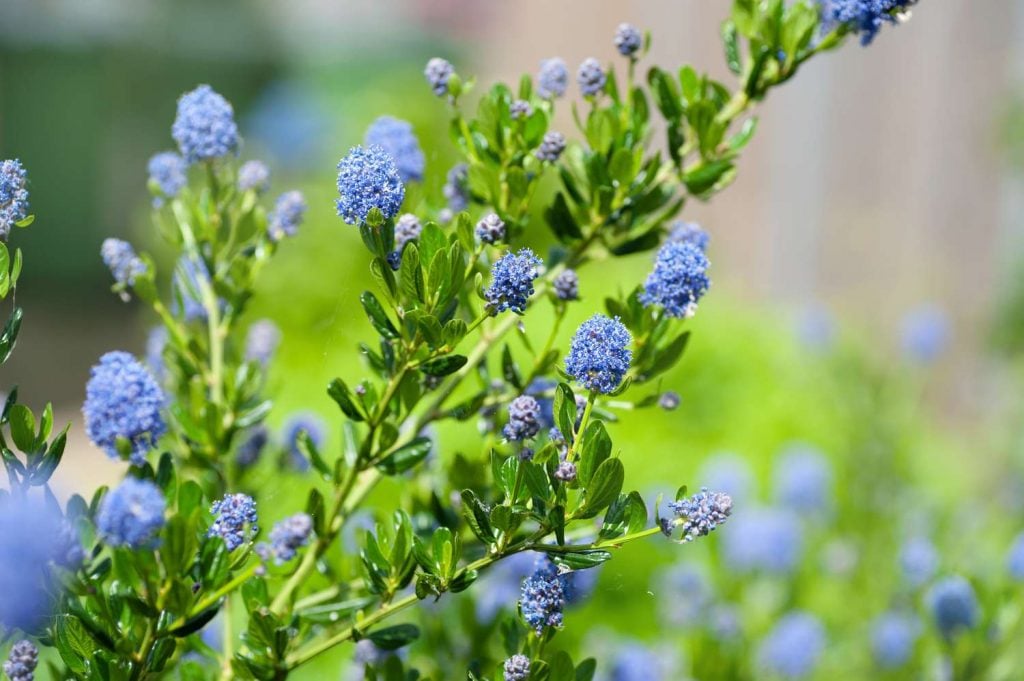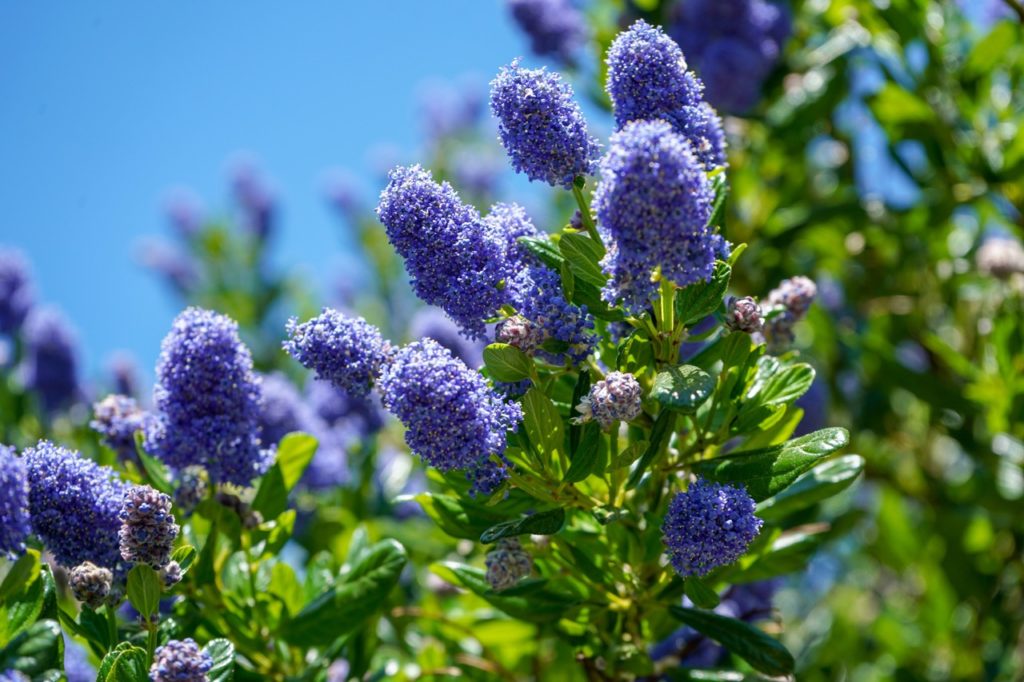Table of Contents
Do you want to see a tree full of blue flowers? It can be visually pleasing for you to see a shrub or a tree full of blue flowers. This is the Ceanothus California Lilac we are talking about. You can have a garden full of flowers in dazzling hues ranging from powder blue to Azure. The Ceanothus are named ‘California lilac’ as these are flowering beds that are native to North America. The flowering season begins in late spring and lasts until early summer.
The peak blooming season is, therefore, for a period of 6 weeks or so. This period is between July- September. Some varieties of the Ceanothus plants bear flowers that are pink or white. These flowers also come to you in a wide variety of sizes. The foliage of the Ceanothus is also quite attractive, and this comprises small dark-coloured leaves. When you have these lovely flowering shrubs inside your garden space, you can attract a variety of bees, butterflies and other forms of pollinators.
Let us learn how to grow the Ceanothus California Lilac in a nutshell.
How to Grow the Ceanothus Planting Beds?

In this segment, we are going to have a look into how to grow Ceanothus shrubs in a delicate yet precise manner. You have outlined steps in relation to the same. Helping you get started here:
1. Positioning the Planting Beds
The California Lilac are flowers that require a proper place to grow. Hence, it is imperative that you find out the exact position where you would prefer to grow the flowering beds. You can opt for a south-facing wall near outdoor or indoor areas to grow these plants in. Although the plants require watering during their initial growth stages, these are exotic flower beds that require little or no water once they are fully grown. As these are delicate shrubs that cannot tolerate hard-core pruning, it is advisable you look for a place where there is enough space for these flowering beds once they are fully established.
2. Amount of Sunlight Required
Most gardeners look for a place where there is full sun. The plant beds also require well-drained soil that facilitates their growth. Therefore, choosing full sun locations is the ideal factor for you to look into when you want the blooms to be good-looking. You can look for afternoon shades in places where the climate is hotter. These are the Southern regions where the plants bloom. Poor light or shade can, however, result in disappointing blooms indeed.
3. Gauge the Type of Soil
You find that Californian Lilacs do well in well-draining soil. The soil must be fertile. Hence, you must not choose soil types that are too heavy or soggy. Again, chalky soil types can cause yellowing of leaves. Therefore, fertile and free-draining lightweight soil is the ideal type you must go in for a while planting the Ceanothus flower beds. However, when you feel that the drainage system in the area is not all that great, then you can opt to plant these shrubs on mounds or slopes. This way, you can facilitate a faster run-off. You can also add organic compost or humus to the soil type so that it drains better.
4. Proper Watering Process
Newly planted shrubs need regular, deep watering. So, once the Ceanothus plants are fully grown, then these flowering beds are quite drought-tolerant. In other words, the plant beds can adapt themselves to arid conditions. When you have hot, dry spells, then these plant beds may require additional irrigation to help them cope. This way, the additional watering can pave the way to healthier and better blooms too. On a general note, the California lilacs do not prefer supplemental watering. Deep soaking does well with the flowering beds as against little watering that is done frequently. These plant beds do not appreciate too wet or soggy soils.
5. Temperature and Humidity
These plant beds are native to California.The California lilacs, therefore, prefer Mediterranean climates that are characterized by mild, wet winters and hot, dry summers. When you opt for the sturdier varieties of these plant beds, then the flowers can withstand frosty weather conditions too. When you opt for evergreen varieties of lilacs, then they may not be able to withstand freezing winters. You can then bring the plant cuttings indoors. You can opt for cooler porches or verandahs to plant them inside pots or containers.
6. Choosing the Right Fertilizers
As these are flowering shrubs that are endowed with natural nitrogen-fixing abilities, these plants do well with infertile soil types too. Therefore, the Ceanothus plants do not require much fertilizer-feeding. However, if you want to encourage a more robust growth of these shrubs after pruning back, then you can mulch the base of the plant with some garden compost or so. While doing so, you must take added care to make sure that you do not mulch too much towards the stems of the planting beds.
7. Pruning Technique
These are shrubs that do not require an intensive level of pruning. In fact, if these delicate shrubs are subjected to an extensive level of pruning, the roots of the shrubs can weaken. Pruning the tips of the branches once the flowering season is over can be ideal for the California lilacs. This can help keep the shape of the plant in a compact manner. A light degree of pruning foliage-free branches is what is intended. This can promote new growth of the branches and foliage. The circulation of air can flow well too. You need to do the pruning after the bloom season is over and not before that. The deciduous ceanothus can do well even after hard pruning. This can be done by cutting back the woody roots that grew in spring the previous year.
8. Propagating California Lilacs
The Ceanothus plant beds are relatively easier to grow from plant cuttings. Usually, these are plant perennials that produce flowers within 2-3 years. You can choose the semi-ripe plant cuttings from evergreen shrubs. This can be done post their blooming season in summer or autumn. For the deciduous variety of shrubs, softwood cuttings can be taken from the new growth of non-flowering tips. You can ideally take the plant cuttings during the spring season. You can dip the plant cuttings in a rooting hormone solution. You must then keep it in a warm, humid spot. For the deciduous variety, you must wait for 4-6 weeks before taking the roots off.
9. Growing California Lilacs from The Seeds
Growing Ceanothus from seeds can be a challenging process indeed. The seeds have a hard seed coat, and therefore, you must soak the seeds in hot water for at least 24 hours. You may have to stratify the seeds for a period of 3 months or so. When you intend to sow them, you must maintain an overall temperature of at least 60-65 degrees Fahrenheit. It can take 3 months for the seeds to germinate.
10. Growing Problems of Ceanothus
The California lilacs are flowers that are easy to grow and maintain. However, there are certain common problems that are attributed to the growing plants. Helping you with what these are in the form of pointers:
- Poorly draining soil can cause the roots of the plant to rot.
- If you use soil that is chalky in nature, then it can lead to yellowing of the leaves. This is mainly because chalky soils are poor in nutrients.
- Windburn or frosty weather conditions can impact the robust growth of the plants if they are over-exposed to these locations.
Discover the Different Types of California Lilacs
Let us move on to discover some exotic varieties of Ceanothus plants.
1. C Arberous ‘Trewithen Blue’

The C Arberous Trewithen Blue is commonly called Californian Lilac- Trewithen Blue. The flowers mainly bloom during the months of spring and summer. The preferred soil types are clay, loam and sand. The flowering beds can grow in soil ranging from alkaline to neutral pH type. These are flowering beds that can grow up to a height of 6 m or so. The spreading evergreen oval shrubs comprise leaves measuring 8 cm long. The florets measure 12 cm long. These are slightly blue flowers that have a good fragrance too.
2. C ‘Blue’ Mound

The C ‘Blue’ Mound is commonly known as California Lilac– Blue Mound. These are flowers that grow together in the form of bunches. The flowering season is during the spring. The preferred soil types are clay, loam and sand. The soil can have an alkaline or a neutral pH. These plant beds can grow to a height of 1.5 m high and have a width of 2.5 m. As the flowers grow in bushes, you can find hundreds of small bright blue flowers under every single cluster. During the full bloom at the time of spring, these flowers can lend a lovely sight to your landscapes or gardens where you have grown them.
3. C ‘Cascade’

The C ‘Cascade’ is commonly known as California Lilac ‘Cascade’. The flowering season is during the Summer. The preferred soil types are Clay, loam and Sand. The soil types range from Alkaline to Neutral pH. This is an evergreen variant of ‘California Lilac’ that grows 4 m tall and wide. The branches have oval-shaped leaves. The light blue flowers grow in petal sizes measuring 8 cm each.
4. C ‘Concha’

The C ‘Concha’ is commonly known as California Lilac ‘Concha’. The flowers start blooming during the spring season. The preferred soil types are clay, loam and sand. These are flowering beds that can adapt to soils ranging from alkaline to neutral pH. The plants grow 3 m high and wide. These are Ceanothus plants that have arching branches with dark-green leaves. The deep blue flowers grow in expansive stretches during the spring weather giving a lovely sight to growing landscapes.
5. C ‘Darkstar’

The C ‘Darkstar’ is commonly known as California lilac ‘Dark Star’. These flowers have hues ranging from blue to purple. The flowering season starts in spring. The preferred soil types are clay, loam and sand. These are flower beds that can adapt to alkaline or neutral pH. The spreading evergreen shrubs grow 2.5 m high and wide. This variant of the Ceanothus has arching branches with dark-green leaves. The flowers in deep blue or purple can give away fabulous looks during the late spring while the bloom is at its peak.
6. C ‘griseus var horizontalis Silver Surprise’

The C ‘griseus var horizontalis ‘Silver Surprise flowering plants are commonly known as California Lilac ‘Silver Surprise’. The flowers are purple-blue with a silvery cascade sparkle. The preferred soil types are clay, loam and sand. These plant beds thrive in any kind of soil ranging from alkaline to a neutral pH type. The full-bloom season starts in spring. The stalks of the plants bear irregular variegated flowers with creamy shaded margins. The plants grow to a height of 1 m spreading over 1.5 m wide. The shrubs filled with purple-blue glossy flowers in spring add great vibes to your garden spaces.
Final Thoughts
All in all, the Californian lilacs, therefore, grow in attractive styles soothing your eyes. The blooms attract quite a number of bees, butterflies and other forms of pollinators. You can have flower cuttings in fabulous bunches and place them in your flower vases. You can adorn your home-living spaces this way. The flowers can be placed in attractive bunches at commercial properties and stylish restaurants too.
These flowers ranging from pale blue and azure to deep purple, blue add value as ornamental pieces too. The flowers grow in clusters, and the blooming season is an entire span of 6-7 weeks, starting spring until late summer months. Some of the variants of the Ceanothus plants bear pink and white flowers too. They are easy to grow and maintain as they require full sun or partially shady locations with a minimal level of watering.
In a nutshell, these are plant perennials that suit indoor spaces and commercial gardens too.





